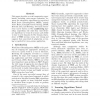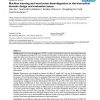150 search results - page 1 / 30 » Four Methods for Supervised Word Sense Disambiguation |
NLDB
2007
Springer
14 years 5 months ago
2007
Springer
Word sense disambiguation is the task to identify the intended meaning of an ambiguous word in a certain context, one of the central problems in natural language processing. This p...
CORR
2000
Springer
13 years 11 months ago
2000
Springer
This paper describes a set of comparative experiments, including cross{corpus evaluation, between ve alternative algorithms for supervised Word Sense Disambiguation (WSD), namely ...
BMCBI
2006
13 years 11 months ago
2006
Background: Word sense disambiguation (WSD) is critical in the biomedical domain for improving the precision of natural language processing (NLP), text mining, and information ret...
ACL
2004
14 years 18 days ago
2004
Supervised learning methods for WSD yield better performance than unsupervised methods. Yet the availability of clean training data for the former is still a severe challenge. In ...
ACL
2003
14 years 17 days ago
2003
In this paper, we proposed a new supervised word sense disambiguation (WSD) method based on a pairwise alignment technique, which is used generally to measure a similarity between...


